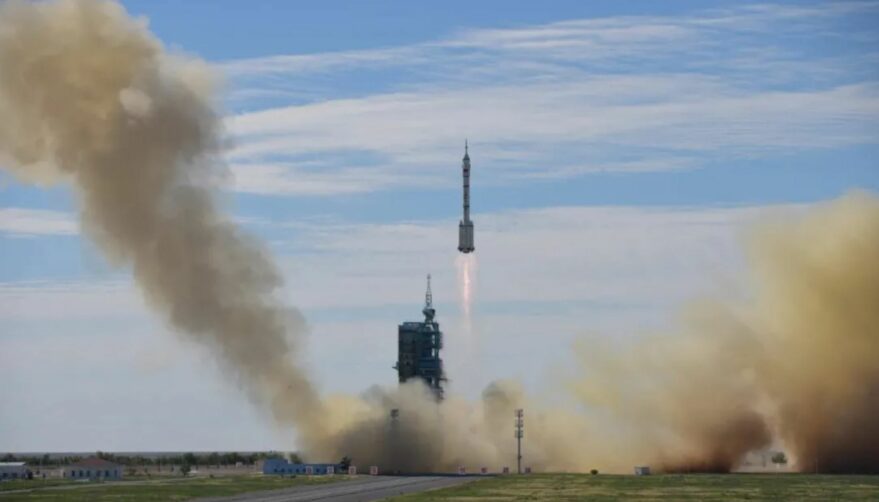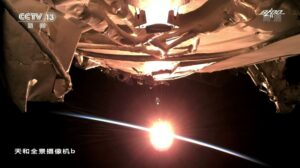Shenzhou-12 and its crew of three launched on a Long March 2F from the Jiuquan Satellite Launch Center at 9:22 p.m. Eastern Wednesday.
The spacecraft docked with the Tianhe space station core module at 3:54 a.m. June 17, six hours 32 minutes after launch, the China Manned Space Engineering Office confirmed.
Astronauts Nie Haisheng, Liu Boming and Tang Hongbo will spend three months aboard the 16.6-meter-long, 4.2-meter-diameter Tianhe (“harmony of the heavens”) module.
Shenzhou-12 mission objectives include extravehicular activities using EVA suits delivered by Tianzhou-2, testing performance of a large robotic arm and verification of a regenerative life support system.
The crewed mission is the third of 11 launches planned for the construction of the three-module Chinese Space Station. The Shenzhou-12 docking was also China’s first autonomous rapid rendezvous and docking while carrying crew.
The outpost is currently in a 375 by 385-kilometer altitude orbit inclined by 41.5 degrees in order to be suitable for visits from Jiuquan.
Docking success! About 6 hours after launch, #Shenzhou12 has successfully docked with #Tiangong space station. Astronauts will enter the space station later. We’ll keep up updated. HD Full process: https://t.co/QPtRTjj90f pic.twitter.com/bXDbuXzIZO
— CNSA Watcher (@CNSAWatcher) June 17, 2021
Tianhe was launched into orbit late April, marking the start of the construction phase of a Chinese space station project first approved in 1992. The Tianzhou-2 cargo spacecraft launched to Tianhe in late May, carrying 4.69 tons of cargo in a pressurized segment to supply the Shenzhou-12 mission. The Shenzhou spacecraft itself carries five days of supplies for the crew.
Shenzhou-12 is commanded by Nie Haisheng, 56, a veteran of the Shenzhou-6 and Shenzhou-10 missions. Also on the mission are Liu Boming, 54, who participated in Shenzhou-7, and Tang Hongbo, 45, making his first flight to space.
The mission is China’s seventh crewed flight. It is planned to far surpass the Chinese human spaceflight duration record of 33 days set by Shenzhou-11 in 2016.
“The training is hard and demanding, as the neutral-buoyancy training is carried out 10 meters under the water at 0.4 atmospheric pressure. The suit is heavy, so that it takes a lot of physical strength even to move hands, bend our arms, loosen a screw, or install something,” Nie said ahead of launch.
“We’ve been preparing for the Shenzhou-12 mission for more than a year, and I think we are capable of the mission and I’m fully confident about fulfilling the mission.”
When the astronauts pass through into Tianhe it will mark the first time since May 2000 that two orbiting space stations will be simultaneously inhabited, when STS-101 and Soyuz TM-30 visited the ISS and Mir respectively. Three Shenzhou flights to small Tiangong space labs took place in 2012, 2013 and 2016—concurrent with permanent ISS habitation—as stepping stone missions towards the larger space station modules.

The China Academy of Space Technology (CAST) has a ground version of Tianhe to be able to test and generate flight programs to solve potential malfunctions experienced by the orbiting core module.
The Tianzhou-3 cargo spacecraft and Shenzhou-13 crewed missions will follow in September and October respectively.
Experiment modules named Wentian and Mengtian are expected to launch in 2022. The pair of 22-ton modules will host a plethora of experiments in areas including astronomy, space medicine, space life science, biotechnology, microgravity fluid physics, microgravity combustion and space technologies.
International science payloads will also fly to the space station, through cooperation between the United Nations Office for Outer Space Affairs (UNOOSA) and the CMSEO. Foreign astronauts are also expected to visit the CSS.



